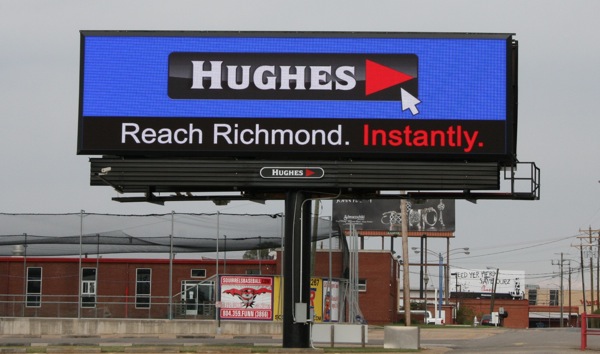A local billboard company has put a high-tech twist on a form of advertising that’s more than a century old.
Hughes Outdoor Media, based in Goochland, converted two billboards near the Boulevard exit on Interstate 95 to a digital format this year. The switch cut down on production and installation costs and lets the company serve more advertisers every day, owner Steve Hughes said.
“This has been in the works for a while,” Hughes said. “We had plans to do this back in 2008, before the economy went south, and had to put it on the shelf.”
It costs about $200,000 to convert a conventional billboard to digital, he said. Because of the steep price and strict zoning regulations for digital media, Hughes said he doesn’t have any more conversions planned.
“You have to have enough traffic to make it worth it,” Hughes said. “Generally, you don’t go out and spend that kind of money to put one up in a rural town.”
Of the 400,000 billboards in the United States, about 3,600 are digital, Hughes said. There are fewer than 20 in the Richmond metro area, but Hughes said he expects more companies make the switch as the costs of LCD screens drop.
The billboards are along I-95.
Hughes said digital boards let clients target specific audiences. For example, an ad for tomato soup is triggered when the temperature falls below 45 degrees, he said.
The cost to advertisers: $1,000 a week to get into a rotation with five other ads. Ads are displayed for five seconds at a time.
The technology behind the digital billboards has been around for a decade, but resolution, energy consumption, weight and programming capabilities have improved dramatically in recent years, Hughes said.
Hughes owns eight billboards in Richmond and more across Central Virginia and North Carolina. Both of his new digital boards on I-95 have been sold out consistently since he made the investment.
A local billboard company has put a high-tech twist on a form of advertising that’s more than a century old.
Hughes Outdoor Media, based in Goochland, converted two billboards near the Boulevard exit on Interstate 95 to a digital format this year. The switch cut down on production and installation costs and lets the company serve more advertisers every day, owner Steve Hughes said.
“This has been in the works for a while,” Hughes said. “We had plans to do this back in 2008, before the economy went south, and had to put it on the shelf.”
It costs about $200,000 to convert a conventional billboard to digital, he said. Because of the steep price and strict zoning regulations for digital media, Hughes said he doesn’t have any more conversions planned.
“You have to have enough traffic to make it worth it,” Hughes said. “Generally, you don’t go out and spend that kind of money to put one up in a rural town.”
Of the 400,000 billboards in the United States, about 3,600 are digital, Hughes said. There are fewer than 20 in the Richmond metro area, but Hughes said he expects more companies make the switch as the costs of LCD screens drop.
The billboards are along I-95.
Hughes said digital boards let clients target specific audiences. For example, an ad for tomato soup is triggered when the temperature falls below 45 degrees, he said.
The cost to advertisers: $1,000 a week to get into a rotation with five other ads. Ads are displayed for five seconds at a time.
The technology behind the digital billboards has been around for a decade, but resolution, energy consumption, weight and programming capabilities have improved dramatically in recent years, Hughes said.
Hughes owns eight billboards in Richmond and more across Central Virginia and North Carolina. Both of his new digital boards on I-95 have been sold out consistently since he made the investment.


Imagine a deal between Verizon or Apple and Hughes which allows Hughes to KNOW which cellphone customers are driving past at the moment.
Minority Report style.
For me the messages change too quickly. By the time I get close enough to read it, it changes and then I pass the sign before I can digest the new message. Maybe it just my old eyes.